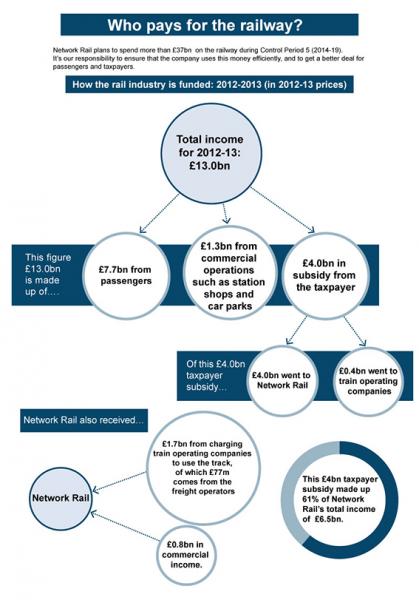What is the periodic review?
Every five years, we review Network Rail's Strategic Business Plan to ensure that it:
- delivers what Westminster and Scottish governments want
- is affordable and offers value for money; and
- puts the needs of passengers and freight users at the heart of our railways.
We started the periodic review for 2014-19, known as control period 5 (CP5), in 2011. We did this by holding a series of public events across Britain and consulting stakeholders, including passenger and consumer groups, train and freight operating companies and local authorities. After an extensive period of further consultation, we published our draft determination in June 2013 and asked people for their views on our proposals. We have now published our final determination, which sets out what we want Network Rail to do in CP5. Our decisions will help to determine how the railway improves and develops safely over the next five years – a time when they have a vital role to play in supporting the national and local economy.
Delivering value for passengers and taxpayers
Britain's railways are vital to the economy. More people and more goods move by train today than they have for many years, with passenger journeys up by more than 50% over the last decade. Last year alone, 1.5 billion passengers used the network – an 8% increase on the previous year. That's 24,000 trains per day.
While a modern, expanding railway is good for the country, it's important that passengers and taxpayers get value for the contribution they make. Over the next five years, Network Rail will need to work harder than ever to ensure maximum value for money – with passenger numbers set to increase by 14% and freight volume by 4%.
While there have been real improvements in performance and efficiency over the past few years, there are still too many occasions when the results aren't as good as they should be.
We've listened very closely to the industry and its customers' views. We've also looked at Network Rail's performance from 2009-13 to see where they have delivered, where performance has not met targets, and what we need to ask them to do for the next five years.
Because Network Rail did not always perform as well as we wanted in this control period, we'll need a change of approach next time around.
Our review looked at Network Rail's Strategic Business Plan in significant depth and detail, drilling down on costs at route level and focusing on major improvement projects and investment in replacing infrastructure such as track, buildings and bridges.
We've also looked at Network Rail's proposed performance for the network in terms of punctuality and reliability, as well as the safety aspects of the company's proposals.
Based on this analysis, and after listening carefully to what Network Rail and other stakeholders have told us, we've asked the company to run the network for £38bn from 2014-19 – that's £1.7bn less than it originally proposed. We've listened when Network Rail has told us it needs more money – and where this has been proved to be justified, we've allocated extra funds.
We've also asked it to do things a bit differently in future and will be taking a much closer look at the business in some key areas.
For example, we've asked Network Rail to:
- improve punctuality levels for all trains and reduce severe delays and cancellations on long distance routes;
- make the network more resilient to extreme weather – including hot temperatures, floods, ice and snow
- improve day-to-day maintenance and develop best practice, moving from a 'find and fix' to a 'predict and prevent' way of working; and
- deliver planned volumes of network renewals, including track and other equipment such as signalling.
ORR will also do things differently in CP5 to help Network Rail secure better results. It's all about getting down to the basics of what drives performance and what needs to be done to make it better. If this is gripped early in the next control period, then performance will improve and money will be spent more efficiently.
More specifically, we will be:
- looking even more closely at Network Rail's performance, particularly how they are managing, maintaining and renewing the network;
- checking closely Network Rail's progress on making the network more resilient to adverse weather;
- being more specific about what is required to improve asset management – and what the priorities should be;
- getting better information from Network Rail to help us decide whether it is performing as well as it possibly can; and
- intervening at an early stage, so that emerging problems don't have the chance to escalate.
We will be very clear with Network Rail what is required at the start of the five-year period, but if its performance improves, then we will be willing to change our approach to monitoring performance.
How the rail industry is funded
Total income for 2011-12: £12.5bn (in 2011-12 prices).
This figure is made up of:
- £7.2bn from passengers
- £1.3bn from commercial operations such as station shops and car parks
- £4.0bn in subsidy from the taxpayer
- £64m from freight
Find out more about how we'll require Network Rail to make efficiency savings.


